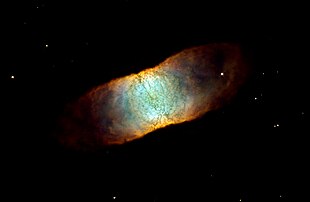Retina-Nebel
| Planetarischer Nebel Retinanebel | |
|---|---|
 | |
| Aufgenommen mit dem Hubble-Weltraumteleskop | |
| AladinLite | |
| Sternbild | Wolf |
| Position Äquinoktium: J2000.0 | |
| Rektaszension | 14h 22m 26,5s [1] |
| Deklination | −44° 09′ 01″[1] |
| Erscheinungsbild | |
| Scheinbare Helligkeit (visuell) | 10,2 mag [2] |
| Scheinbare Helligkeit (B-Band) | 10,6 mag [2] |
| Winkelausdehnung | 1,77´ |
| Zentralstern | |
| Bezeichnung | Gaia DR3 6102472263541814272 |
| Scheinbare Helligkeit | 17,2 mag |
| Physikalische Daten | |
| Entfernung | 3720 ± 510 Lj |
| Durchmesser | (0,25 × 0,9) Lj |
| Geschichte | |
| Entdeckung | DeLisle Stewart |
| Datum der Entdeckung | 1899[3] |
| Katalogbezeichnungen | |
| IC 4406 • PK 319+15.1 • PN G319.6+15.7 • ESO 272-PN6 • | |
Der Retina-Nebel ist ein planetarischer Nebel im Sternbild Wolf. Die Katalog-Bezeichnung ist IC 4406.
Zu sehen ist ein torusförmiger Ring, den man von der Erde aus von der Seite sieht. Dieser ist durchsetzt von feinen schwarzen Linien (deshalb Retina), die den Grenzbereich zwischen den im sichtbaren Licht und im Radiobereich emittierenden Gas- und Staubwolken bilden.
Literatur
- König, Michael & Binnewies, Stefan (2023): Bildatlas der Sternhaufen & Nebel, Stuttgart: Kosmos, S. 200
Weblinks
- H. Heintzmann: IC 4406: Untergang in Anmut. Universität zu Köln, archiviert vom am 10. März 2007.
- IR-Aufnahme des Spitzer Weltraumteleskops
- IC 4406 in SIMBAD
Einzelnachweise
Auf dieser Seite verwendete Medien
The Hubble telescope reveals a rainbow of colors in this dying star, called IC 4406. Like many other so-called planetary nebulae, IC 4406 exhibits a high degree of symmetry. The nebula's left and right halves are nearly mirror images of the other. If we could fly around IC 4406 in a spaceship, we would see that the gas and dust form a vast donut of material streaming outward from the dying star. We don't see the donut shape in this photograph because we are viewing IC 4406 from the Earth-orbiting Hubble telescope. From this vantage point, we are seeing the side of the donut. This side view allows us to see the intricate tendrils of material that have been compared to the eye's retina. In fact, IC 4406 is dubbed the "Retina Nebula."
